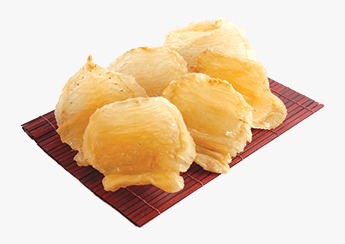
Shipping and Handling
Selecting the Bird's Nest
House nests are swiftlet’s nests that are collected under the eaves of houses. House nests are a rich source of proteins and amino acids, of a softer texture, and have strong water retention. House nests are often large whole nests, with soft texture, less hair, and (If white nest) of a rice-white, semi-transparent colour. After cooking, those house nests that develop a gentle fragrance and softer texture and do not dissolve are categorised as top grade products.
In contrast, white nests normally have a stronger aroma and softer texture, while also possessing higher protein, sugars, and amino acids. Accordingly, white nests are more suitable for daily/normal consumption.
All about Bird's Nest
The Chinese character for “Bird's Nest” is well recognised and the benefits of consuming Bird's Nest have been known by Chinese for centuries.
This is the wild bird's nest and mainly comes from the caves of Southwest Thailand and Java Island in Indonesia. Cave nests are generally found with tiny feathers and a firm texture and their nutrient value is comparatively higher than house nests.
House Nest:
The swiftlet builds the nest inside a house known as a ‘swiftlet house’. It is believed to be a sign of good fortune when a swiftlet builds a nest inside the house. House nests are generally referred to as white bird's nests. They contain less feathers than cave nests. Their texture is especially tender and soft after they are cooked.
White nests are the most common bird's nest found in the market. Bird's nest is the hardened saliva of swiftlets, containing elements which can stimulate tissue and cell growth. They are suitable for all ages in all seasons. Most of the bird's nests found in the cave are from Malaysia, Indonesia, Thailand and Vietnam.
Golden Nest:
Golden nests are more expensive than white nests and can only be found in selected caves. The colour of the nest is due to the natural environment and composition of the limestone rock. They contain more minerals and are rich in proteins. They are best suited to pregnant women and middle-aged adults.
Red Nest:
Red nests are limited in availability and highly valuable. Swiftlets produce the nest at selected caves. The colour of the nest is formed due to the natural environment and composition of the limestone rock. Red nests have a higher content of iron and are rich in minerals and proteins. They help to replenish blood and calcium. They are best suited to recovering patients and the elderly.
According to Chinese Medicine, natural bird's nests enrich vital energy and fluid in the human body and help to relieve cough and phlegm. They are beneficial to the human body because they are rich in minerals such as calcium, potassium and phosphorus.
Appetitive:
Bird's nests accelerate metabolism and promote skin growth. They are a good appetiser and health supplement for people, especially the elderly and children.
Youthful Complexion: Bird's nests are rich in glycoprotein and various minerals, which help promote metabolism and skin growth. These unique elements are a perfect remedy to nourish skin and maintain a healthy glow and youthful complexion.
Indispensable Supplement:
Bird's nest is a valuable natural supplement which is easily absorbed by the human body. Because of its neutral properties, it is an indispensable supplement for all ages.
Nutrients:
The nutritional value of bird’s nest is well established. Modern scientific research has indicated that bird’s nests contain around 49.9% glycoprotein. This protein promotes tissue and cell growth reproduction, strengthens body health and accelerates recovery from illness. Bird’s nest is also rich in amino acids and minerals such as calcium, phosphorus and potassium.
Look:
Bird's nest should have a dense fibrous appearance and irregular thread-like texture. The distribution of the colour in red nests should be uneven. Be cautious if the colour of the red nest is evenly distributed.
Smell:
Bird's nest has its own unique aroma. It delivers a natural ‘egg-like’ taste after stewing. Something ‘fishy’ or ‘greasy’ is a fake bird’s nest.
Touch:
Soak and pull it. A fake bird’s nest is likely to be easily broken and of low elasticity.
Soak:
The natural environment causes the nest to be red or yellow. The colour remains unchanged, even after cooking.
Moisture content is another consideration when making a purchase. The price will be much lower if the bird’s nest has less moisture. If the bird’s nest is too dry, it will crack easily.
•The bird's nest will expand after soaking. Use pincers to extract impurities or feathers and then place the bird’s nest in a sifter for cleaning.
•Operation of the steaming pot at ‘low heat’ is recommended to retain the bird's nests nutrients.
Our product Guarantee:
No Preservative
No Stabiliser
No Artificial Colouring
No Artificial Flavouring
Glycoprotien
Edible Bird’s Nest also contains Glycoprotein which is believed to play a pivotal role in our biological systems. The diverse functions of Glycoprotein include enabling connectivity and communication between cells and up regulates tight junction membrane proteins.
Culinary Use
The most famous use of edible birds nest is bird's nest soup, a delicacy in Chinese cuisine. When dissolved in water, the birds' nests have a gelatinous texture used for soup or sweet soup [tàhng suay]. It is mostly referred to as 燕窝 [yàn wō] unless references are made to the savoury or sweet soup in Chinese cuisine.
Harvesting
The most heavily harvested nests are from the edible-nest swiftlet or white-nest swiftlet (Aerodramus fuciphagus) and the black-nest swiftlet (Aerodramus maximus).The white nests and the red nests are supposedly rich in nutrients, which are traditionally believed to provide health benefits.
